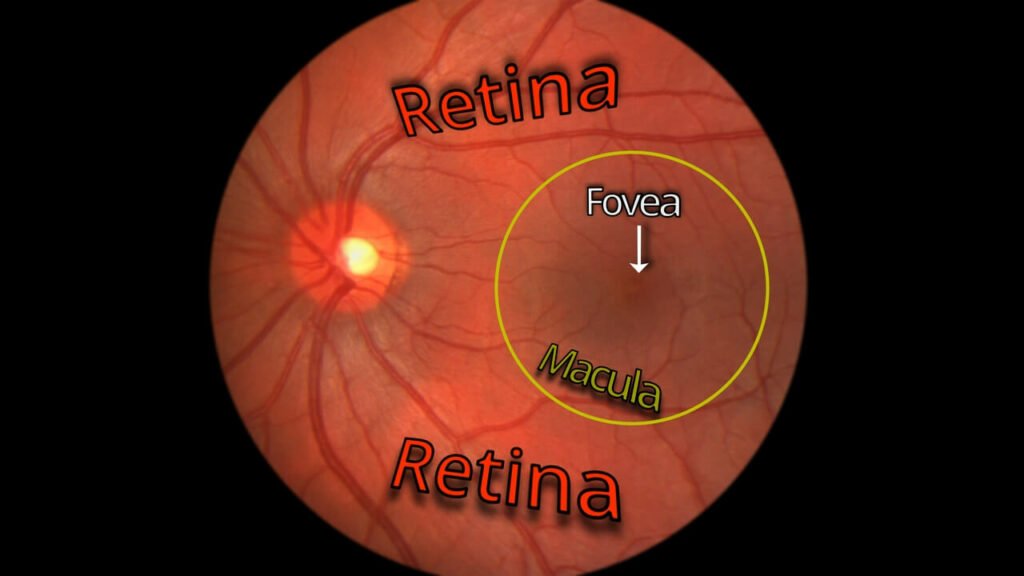What is a Fovea?

Fovea Defined
The word “fovea” means “depression” or “pit”. There is also a tiny point (about the size of tip of a pin) on our retina in the back of our eye (directly behind the pupil) called the fovea, because it is an area of the macula that is depressed a little, like a tiny pit.
The macula is an area of the retina that is associated with our central vision, and the fovea is the epicenter of the macula (so sometimes referred to as the fovea centralis) that is responsible for our sharpest vision.
The Fovea’s Role in Eyesight
Our fovea is used for “what we look at”, like words when we are reading, or the bullseye when we are aiming at a target. The fovea is densely packed with photoreceptors (light receiving cells) called “cones” that detect light and enable color perception.
Different cones respond to different sources of light. For example, there are blue cones that are stimulated by blue light, red cones that are stimulated by red light, and green cones that are stimulated by green light. Therefore, much like millions of pixels emitting light from a television independently to create an image, there are millions of foveal cones that are responsive to certain colors of light that each transfer the image details to the brain for processing.
The fovea has a very fine tuned ratio of cone:nerve (as low as 1:1) for precise image representation detail. This ratio of cells to nerve is what allows for the finest detail viewing.
How do Contact Lenses Work with the Fovea?
For our best vision, light must focus on the fovea. When an eye doctor is fine tuning your prescription glasses or contact lenses, they are trying to focus light directly on the fovea. Vision problems, such as hyperopia, myopia, and astigmatism, improperly focus light and cause the fovea to receive a blurred image.
Your prescription is a measurement in diopters of how far the off-focus point in your eye must be moved to focus light directly on the fovea. Contact lenses are designed to correct these off-focus points, called refractive errors, ensuring that light entering the eye is ultimately focused directly on the fovea. A well-fitted contact lens ensures that the image is sharply focused onto the fovea, providing clear central vision.
Common Vision Conditions that Involve the Fovea
- Macular Degeneration: Since the fovea is the center and most important part of the macula, when the macula degenerates, the risk of the fovea degenerating or experiencing damage also exists. The damage associated with macular degeneration overall leads to a potential loss of central vision in varying degrees.
- Macular Pucker/Epiretinal Membrane/Vitreo-Macular Traction: When a surface membrane thickens over the macula, the macula is “tugged” by the overlying vitreous. This traction often involves the fovea. Disruption or redistribution of the foveal cone alignment can often lead to vision loss or distortion. In the end case of this traction, a macular hole can develop.
- Macular Hole: When damage occurs from inflammation, UV damage, trauma, or vitreomacular traction, a hole can develop in the macula that usually includes the fovea. Since the fovea is an area of our most detailed vision, a hole in it can greatly reduce vision.
- Diabetic Retinopathy/Maculopathy: Diabetes is a vascular disease that affects blood vessels throughout the body. Blood vessels carry oxygen and nutrients within the blood to the retina, macula, and fovea. When diabetes is left uncontrolled, damage to these blood vessels can cause fluid leakage and loss of oxygen support at the fovea, which can compromise vision.
- Glaucoma: Though glaucoma is more known for peripheral vision loss and is associated with high ocular pressures, it can also affect our central vision even at normal ocular pressures. Recent acknowledgement of the macula being affected in early stages of glaucoma is advancing our understanding of treatment of glaucoma. The greatest impact to vision loss from glaucoma usually occurs when the fovea is affected.
Tips for Maintaining Eye Health of the Fovea
- Regular Optometric/Ophthalmic Eye Exams: Get your eyes tested regularly from a professional who specializes in the eye. Since the fovea is the most important point in the back of your eye, your eye doctor examines it at nearly every visit.
- Sunglasses/UV blocking contact lenses: Ultraviolet light is associated with advancing conditions such as macular degeneration (and the fovea is part of the macula).
- Diet: Maintaining a balanced nutritional diet, especially one that is rich in antioxidants (such as green leafy vegetables) and omega 3 (such as fish) are known to promote retinal health.
- Avoid Smoking: Overall, smoking decreases health and increases oxidants, therefore, increases the risk of eye conditions, including macular degeneration.
- Physical fitness: The eyes are part of the body, so it is important to maintain overall health to maintain healthy eyes. (Healthy Body = Healthy Eyes)
Need Consistanly Cheap Contacts?
DeliverContacts.com always guarantees you are paying low prices, every time you buy. We will never play games with our pricing or take part in manipulative discounts. Just consistently cheap contacts, forever.
Give your box a search below and see for yourself! 100% Free shipping and returns on all products!
Check out our most popular lenses
Get The Lowest Prices, Forever!
We will never send you junk or give out your information. The only emails you'll get from us are ones you be glad you got.
